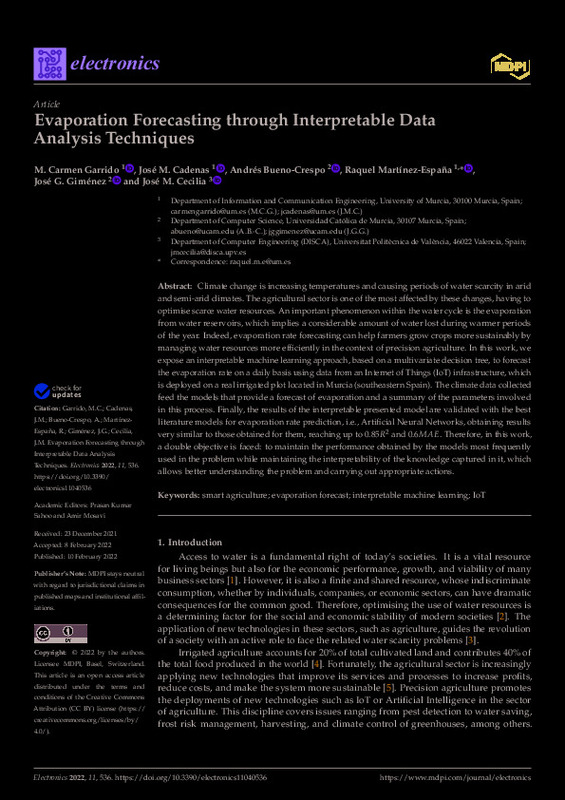JavaScript is disabled for your browser. Some features of this site may not work without it.
Buscar en RiuNet
Listar
Mi cuenta
Estadísticas
Ayuda RiuNet
Admin. UPV
Evaporation Forecasting through Interpretable Data Analysis Techniques
Mostrar el registro sencillo del ítem
Ficheros en el ítem
| dc.contributor.author | Garrido, M. Carmen
|
es_ES |
| dc.contributor.author | Cadenas, José M.
|
es_ES |
| dc.contributor.author | Bueno-Crespo, Andrés
|
es_ES |
| dc.contributor.author | Martínez-España, Raquel
|
es_ES |
| dc.contributor.author | Cecilia-Canales, José María
|
es_ES |
| dc.contributor.author | Giménez, José G.
|
es_ES |
| dc.date.accessioned | 2023-05-08T18:02:14Z | |
| dc.date.available | 2023-05-08T18:02:14Z | |
| dc.date.issued | 2022-02 | es_ES |
| dc.identifier.uri | http://hdl.handle.net/10251/193221 | |
| dc.description.abstract | [EN] Climate change is increasing temperatures and causing periods of water scarcity in arid and semi-arid climates. The agricultural sector is one of the most affected by these changes, having to optimise scarce water resources. An important phenomenon within the water cycle is the evaporation from water reservoirs, which implies a considerable amount of water lost during warmer periods of the year. Indeed, evaporation rate forecasting can help farmers grow crops more sustainably by managing water resources more efficiently in the context of precision agriculture. In this work, we expose an interpretable machine learning approach, based on a multivariate decision tree, to forecast the evaporation rate on a daily basis using data from an Internet of Things (IoT) infrastructure, which is deployed on a real irrigated plot located in Murcia (southeastern Spain). The climate data collected feed the models that provide a forecast of evaporation and a summary of the parameters involved in this process. Finally, the results of the interpretable presented model are validated with the best literature models for evaporation rate prediction, i.e., Artificial Neural Networks, obtaining results very similar to those obtained for them, reaching up to 0.85R2 and 0.6MAE. Therefore, in this work, a double objective is faced: to maintain the performance obtained by the models most frequently used in the problem while maintaining the interpretability of the knowledge captured in it, which allows better understanding the problem and carrying out appropriate actions. | es_ES |
| dc.description.sponsorship | This work is derived from R & D project RTC-2017-6389-5 funded by MCIN/AEI/10.13039/ 501100011033 and FEDER a way of making Europe, as well as the Ramon y Cajal Grant RYC2018-025580-I, funded by MCIN/AEI/10.13039/501100011033 and by FSE invest in your future. Furthermore, this work is part of the project of I+D+i PID2020-112675RB-C44, funded by MCIN/AEI/10.13039/501100011033. | es_ES |
| dc.language | Inglés | es_ES |
| dc.publisher | MDPI AG | es_ES |
| dc.relation.ispartof | Electronics | es_ES |
| dc.rights | Reconocimiento (by) | es_ES |
| dc.subject | Smart agriculture | es_ES |
| dc.subject | Evaporation forecast | es_ES |
| dc.subject | Interpretable machine learning | es_ES |
| dc.subject | IoT | es_ES |
| dc.title | Evaporation Forecasting through Interpretable Data Analysis Techniques | es_ES |
| dc.type | Artículo | es_ES |
| dc.identifier.doi | 10.3390/electronics11040536 | es_ES |
| dc.relation.projectID | info:eu-repo/grantAgreement/AEI/Plan Estatal de Investigación Científica y Técnica y de Innovación 2017-2020/PID2020-112675RB-C44/ES/ADAPTACION DE RECURSOS DE COMPUTO Y RED DESDE LA NUBE AL EXTREMO: EXPLOTANDO LA ORQUESTACION INTELIGENTE Y LA SEGURIDAD (ONOFRE-3-UMU)/ | es_ES |
| dc.relation.projectID | info:eu-repo/grantAgreement/AGENCIA ESTATAL DE INVESTIGACION//RTC-2017-6389-5-AR//PLANIFICACIÓN Y GESTIÓN DE RECURSOS HÍDRICOS A PARTIR DE ANÁLISIS DE DATOS DE IOT/ | es_ES |
| dc.relation.projectID | info:eu-repo/grantAgreement/AGENCIA ESTATAL DE INVESTIGACION//RYC2018-025580-I//AYUDA CONTRATO RAMON Y CAJAL-CECILIA CANALES/ | es_ES |
| dc.rights.accessRights | Abierto | es_ES |
| dc.contributor.affiliation | Universitat Politècnica de València. Departamento de Informática de Sistemas y Computadores - Departament d'Informàtica de Sistemes i Computadors | es_ES |
| dc.description.bibliographicCitation | Garrido, MC.; Cadenas, JM.; Bueno-Crespo, A.; Martínez-España, R.; Cecilia-Canales, JM.; Giménez, JG. (2022). Evaporation Forecasting through Interpretable Data Analysis Techniques. Electronics. 11(4):1-36. https://doi.org/10.3390/electronics11040536 | es_ES |
| dc.description.accrualMethod | S | es_ES |
| dc.relation.publisherversion | https://doi.org/10.3390/electronics11040536 | es_ES |
| dc.description.upvformatpinicio | 1 | es_ES |
| dc.description.upvformatpfin | 36 | es_ES |
| dc.type.version | info:eu-repo/semantics/publishedVersion | es_ES |
| dc.description.volume | 11 | es_ES |
| dc.description.issue | 4 | es_ES |
| dc.identifier.eissn | 2079-9292 | es_ES |
| dc.relation.pasarela | S\462565 | es_ES |
| dc.contributor.funder | AGENCIA ESTATAL DE INVESTIGACION | es_ES |
| dc.contributor.funder | Agencia Estatal de Investigación | es_ES |
| dc.contributor.funder | European Regional Development Fund | es_ES |








